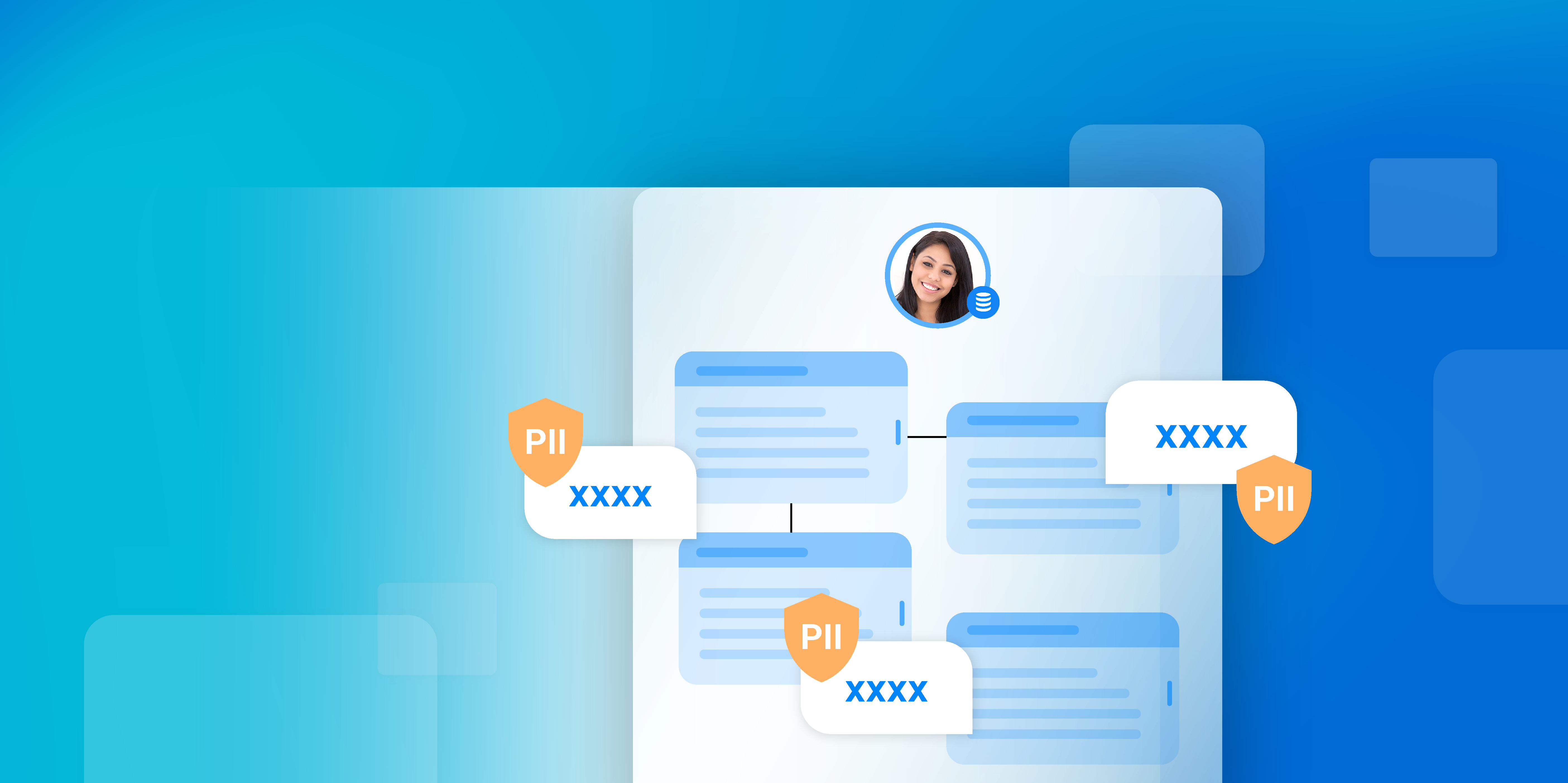PII masking is the process of hiding any personally identifiable information in order to protect individual identities and comply with data privacy laws.
What is PII?
Personally Identifiable Information (PII) is any data that can be used to identify someone. PII can be anything from direct identifiers, such as names, phone numbers, addresses, and social security numbers, to indirect identifiers, like gender, date of birth, and zip code.
In the digital age, the scope of PII has expanded to include online identifiers such as IP addresses and device information, which can be combined with other data to reveal an individual’s identity.
Data privacy regulations have catapulted sensitive data discovery and PII masking into the limelight.
Why does PII matter?
It’s nearly impossible to do business today without collecting PII. Many believe that PII allows companies to:
-
Tailor products and services to better serve their customers
-
Personalize messages to enhance the user experience
The problem is that PII can also be shared or sold to other organizations, explaining why we receive so many unsolicited ads and promotions.
It can also fall into the wrong hands. Hackers can use PII to commit identity theft, hold it through ransomware, or sell a user’s data on the black market. It’s more common than you think. In IBM’s 2022 “Cost of a Data Breach” report, it was reported that over 80% of the companies surveyed have experienced some sort of data breach. That's why PII masking is critical to the business world.
Types of PII
Allowing for differences of opinion, PII is generally classified as either sensitive or non-sensitive. In addition to names, addresses, and Social Security Numbers, sensitive PII includes direct identifiers like someone’s driver’s license number, credit card details, passport information, financial statements, medical records, etc.
Non-sensitive PII (also known as indirect PII) includes data like zip code, gender, date of birth, place of birth, religion, and more. This data could belong to multiple people, but when combined with other data, it can be used to identify an individual.
Like everything else, PII is constantly evolving. Today, online activities generate vast amounts of user data, including browsing habits, preferences, and behavioral patterns.
The more data is available about an individual online, the higher the risk of PII falling into the wrong hands, and the greater the need for PII discovery and PII masking.
Direct PII can be used for identity theft, enabling fraudsters to open fake accounts, apply for credit cards, or conduct other activities under their victims' identities. Indirect PII – even information like social media posts, shopping habits, and online behaviors – can be used in sophisticated social engineering attacks, where hackers craft convincing phishing emails, tailored to individual preferences, to deceive targets into giving away sensitive information.
One notable example of hackers using PII is “credential stuffing” attacks. When attackers get their hands on someone's login credentials, often through data breaches involving PII, they can exploit the well-known tendency to reuse passwords across multiple platforms. By automating login attempts using these stolen credentials on various websites, these malicious actors gain unauthorized access to multiple accounts at once. This practice underscores the interconnectedness of direct and indirect PII, in the sense that information collected from one source can be used to exploit vulnerabilities in others.
Challenges of PII masking
For companies, the challenges of PII masking include:
-
Functionality vs security
One of the primary challenges in handling PII lies in striking the delicate balance between functionality and security. Developers face the task of creating feature-rich applications while ensuring that sensitive information remains protected. This requires a nuanced approach, incorporating meticulous coding practices and a deep understanding of security principles.
-
Impact of data breaches
Data breaches pose significant threats to software development projects. Beyond financial implications, breaches erode user trust and tarnish a company's reputation. Developers must be acutely aware of the potential risks associated with PII mishandling and take proactive measures to prevent data breaches, such as implementing strict access controls and encryption protocols.
-
Legal compliance with GDPR, CPRA, and other regulations
Regulations like the EU’s General Data Protection Regulation (GDPR) and the California Privacy Rights Act (CPRA) impose stringent requirements on handling PII, such as an individual’s right to limit its use, or delete it completely. Companies must ensure compliance with these laws to avoid significant legal and financial consequences.
Best practices in PII masking for developers
PII is not merely a consideration; it’s an integral part of every phase of the software development life cycle. From the conceptualization of a project to its deployment and subsequent maintenance, developers must consistently prioritize and safeguard PII.
PII protection in software development starts with implementing robust data masking techniques and adhering to secure coding practices. Masking data at rest and in transit adds an extra layer of security, making it more challenging for unauthorized entities to access sensitive information.
Additionally, regular audits of software systems and data handling practices are essential for identifying vulnerabilities. Developers should employ risk mitigation strategies, such as conducting penetration testing and staying informed about emerging threats, to proactively address potential security risks.
Quality assurance processes should incorporate specific checks for PII protection. This includes validating data handling procedures, testing for masking effectiveness, and ensuring compliance with relevant privacy regulations.
Get Gartner’s market guide for data masking FREE.
PII masking via business entities
As discussed, one of the most effective methods for protecting PII is through data masking. The first step to masking PII is revealing it.
K2view data masking tools have a built-in AI-powered PII discovery capabilities that enable your Large Language Model (LLM) to identify and classify all your data, wherever it is. They also assure full referential integrity and semantic consistency across all systems. While, advanced techniques like dynamic data masking help strike the right balance between data protection and utility.
Entity-based data masking technology addresses the challenges of PII masking by ingesting, organizing, and masking data from different sources by business entity (a specific customer, order, or device). A business entity approach allows teams across the company to access the information they need, when they need it – knowing that the data is always consistent, complete, compliant, and protected.
Learn how K2view entity-based data masking tools discover and mask PII.













